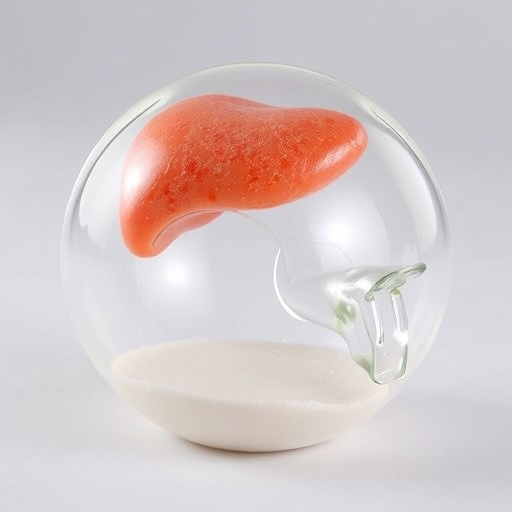In a groundbreaking study that promises significant advancements in understanding the protective roles of chemical agents against cellular damage in cancer treatment, researchers have examined the effects of sodium thiosulfate on pancreatic and liver damage caused by cyclophosphamide and ionizing gamma radiation. The study, conducted by esteemed scientists Kassem, Taha, and Hassan, delves into the biochemical pathways and physiological effects of sodium thiosulfate, shedding light on its potential as a therapeutic agent.
Cyclophosphamide, a well-known chemotherapeutic agent, is frequently employed in cancer treatment regimens. However, its beneficial effects are often overshadowed by its propensity to induce severe side effects, particularly on vital organs like the pancreas and liver. Understanding these detrimental impacts is crucial for oncologists seeking to optimize treatment protocols while minimizing harm to patients. This team of researchers has ventured into the complexities of this issue, exploring how exogenous agents could mitigate the toxic effects of such treatments.
In their comprehensive analysis, the researchers employed male albino rats, a standard model in pharmacological research, to observe the impacts of sodium thiosulfate. The application of this hydrogen sulfide donor is particularly intriguing as hydrogen sulfide is known to play significant roles in cellular signaling and could potentially counteract the oxidative stress induced by cyclophosphamide and gamma radiation. This innovative approach could pave the way for novel combination therapies that prioritize patient safety and recovery.
The team meticulously monitored various biological markers indicative of liver and pancreatic function in the test subjects. Parameters such as enzyme levels, histopathological changes, and inflammatory responses were meticulously assessed before and after the administration of sodium thiosulfate. It was expected that this rigorous methodology would yield insights into how sodium thiosulfate can function as a protector against chemically induced damage.
As the results unfolded, they revealed a fascinating narrative. Sodium thiosulfate demonstrated a remarkable ability to alleviate the detrimental effects on the pancreas and liver, showcasing its protective properties. These findings suggest that sodium thiosulfate may reduce oxidative stress markers and inflammatory responses that typically elevate following cyclophosphamide treatment. Such outcomes could indicate a new frontier in reducing organ toxicity in cancer therapies.
Additionally, the researchers highlighted the significance of the timing and dosage of sodium thiosulfate administration. Objective optimization of these parameters is essential for translating these findings into clinical practice. If confirmed in further studies, the timing of treatment could represent a critical determinant in enhancing patient outcomes and mitigating the adverse effects experienced post-chemotherapy.
Although the study primarily underscores the potential of sodium thiosulfate, it also calls attention to the underlying mechanisms through which this phosphene acts. Hydrogen sulfide, as a signaling molecule, is known for its myriad effects on various biological pathways, including inflammation, apoptosis, and cellular repair. The interaction between sodium thiosulfate and these pathways is critical for understanding its role in mitigating damage.
Furthermore, the implications of such research extend beyond chemotherapy. The protective effects of sodium thiosulfate could also be relevant in other therapeutic contexts, particularly in radiation therapy, where damage to healthy tissues is a significant concern. This broadens the potential applicability of sodium thiosulfate as a universal protector against oxidative stress-induced damage across various medical fields.
The study published in BMC Pharmacology and Toxicology sets a precedent for future investigations into similar compounds and their protective roles. Identifying and characterizing additional agents that can mitigate the side effects of powerful cytotoxic drugs can revolutionize cancer treatment and improve the quality of life for patients.
In essence, the findings of Kassem, Taha, and Hassan could lead to vital changes in therapeutic strategies employed in oncology. This research underscores a paradigm shift wherein the focus may not solely be on the cytotoxic efficacy of cancer treatments but also on their safety profiles. As the field of cancer therapeutics evolves, integrating protective agents like sodium thiosulfate might become standard practice, providing a dual benefit of effective tumor reduction while preserving organ function.
In conclusion, the study exemplifies the commitment to improving cancer treatment outcomes through innovative research. As the scientific community continues to explore the spectrum of pharmacological interventions, it will be fascinating to see how sodium thiosulfate and similar compounds will be incorporated into clinical practices, ultimately enhancing the lives of those undergoing cancer therapies.
This exciting new research opens doors to a future where cancer treatment may become safer and more effective, leading to better patient experiences and improved recovery rates.
Subject of Research: The protective effects of sodium thiosulfate against pancreatic and liver damage induced by cyclophosphamide and gamma radiation in male albino rats.
Article Title: Sodium thiosulfate (hydrogen sulfide donor) ameliorates the pancreatic and liver damage induced by cyclophosphamide and/or ionizing gamma radiation in male albino rats.
Article References: Kassem, A., Taha, E.F.S., Hassan, A. et al. Sodium thiosulfate (hydrogen sulfide donor) ameliorates the pancreatic and liver damage induced by cyclophosphamide and/or ionizing gamma radiation in male albino rats.
BMC Pharmacol Toxicol 26, 178 (2025). https://doi.org/10.1186/s40360-025-01011-0
Image Credits: AI Generated
DOI: 10.1186/s40360-025-01011-0
Keywords: sodium thiosulfate, pancreatic damage, liver damage, cyclophosphamide, gamma radiation, hydrogen sulfide donor, cancer therapy, chemoprotection, oxidative stress, inflammation.




